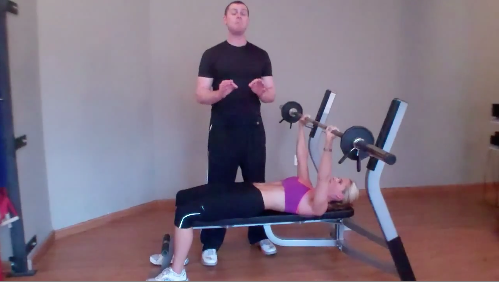Research Review: Longer Interset Rest Periods Increase Repetition Performance in Both Multi- and Single-Joint Exercises
By Nicholas Rolnick SPT, MS, CSCS
Edited by Brent Brookbush DPT, PT, COMT, MS, PES, CES, CSCS, ACSM H/FS
Original Citation: Senna G, Willardson JM, Salles BF, Scudese E, Carneiro F, Palma A, Simão R. The effect of rest interval length on multi and single-joint exercise performance and perceived exertion. J Str Cond Res. Nov 2011; 25(11): 3157-3162. ABSTRACT
Why the Study Is Relevant: The American College of Sports Medicine suggests 2-3 minutes of interset rest for multi-joint movements, and 1-2 minutes rest for single-joint movements (1). This 2011 study by Brazilian researchers suggests longer rest periods (3 - 5 minutes) promote completion of more repetitions and more total volume, especially between multi-joint movements.

Bicep Curls was one of the single-joint exercises in this study. Model: Nicholas Rolnick
Study Summary
| Study Design | Cohort Study, within-Subjects Design |
| Level of Evidence | IB Evidence from at least one randomized controlled trial |
Subject Characteristics
|
Inclusion Criteria
Exclusion Criteria
|
| Methodology |
Effect sizes were calculated to investigate the magnitude of the effect of the interset rest interval on repetitions during the different exercises. |
| Outcome Measures | |
| Results | Excellent test-retest reliability was observed for each exercise (r = 0.92-0.98) and no significant differences were observed in the test-retest 10RM testing (p > 0.05) Repetitions Completed
|
| Our Conclusions | Modulating the interset rest period depending on the exercise can have important implications on volume (reps x sets) and volume load (reps x sets x load). This may have implications on interest rest periods for all phases of resistance training programming (endurance, hypertrophy, strength and power). |
| Researchers' Conclusions | Increasing interset rest periods can significantly affect the number of repetitions completed and the perceived exertion across a 5-set 10RM exercise workout in resistance-trained males. Five-minute interset rest periods confer the largest benefit to maintaining the amount of repetitions completed across sets, with 1-minute rest intervals showing the opposite trend. All exercises showed significant increases in RPE with increased sets, with 1-minute rest interval group showing the highest RPEs. |

Bench press was one of the multi-joint exercises used in this study.
Review & Commentary:
The American College of Sports Medicine suggests 2-3 minutes of interset rest for multi-joint movements, and 1-2 minutes rest for single-joint movements (1). This study added to a growing body of literature suggesting that longer rest periods may be more beneficial (2 - 4).
The study had many methodological strengths, including:
- The protocol was very clear, allowing for replication. The authors described the subjects, wrote detailed descriptions of how the experiment was carried out, and used appropriate statistical analyses to draw their conclusions. The randomized within-subject design also strengthens the results, as subjects underwent each experimental condition. The data published was also comprehensive, reducing reporting bias.
- The study used 4 exercises frequently used in resistance-training programs. Inclusion of these exercises increases clinical relevancy and generalizability.
- The authors provided reliability data for each of the protocols and assessment tools associated with their primary outcomes.
- Previous studies have investigated the effect of interset rest periods on exercise performance (completed repetitions), but no studies have directly compared multi- and single-joint exercises in one intervention. This study filled a gap in the literature by comparing these types of exercises and the effect on exercise performance and perceived exertion.
Weaknesses that should be noted prior to clinical integration of the findings include:
- The subject size was fairly small, only fifteen resistance-trained males participated in this study. While significance was achieved between groups, it is not known whether or not additional subjects would have further stratified the results. Specifically, differences between 3- and 5-minute groups could hold important clinical significance with respect to exercising time.
- There was no mention of the subjects' nutritional intakes. Nutrition could have influenced how subjects responded to the training protocol. Future research should include a diet journal to minimize the chance that diet influenced outcomes.
- The study investigated 15 men, using 4 machine exercises (2 multi-joint, 2 single-joint) commonly used in fitness, rehab and performance settings. Results may not be generalizable to other groups or modalities. Future research should expand on the types of exercises used and vary the loading schemes to increase generalizability.
Why This Study Is Important
The study provides evidence that longer interset rest periods (3- and 5-minutes) aid in maintaining repetition ranges from set to set when compared to shorter rest periods, regardless of whether a single- or multi-joint is performed. All groups exhibited similar patterns in repetition performance and rate of perceived exertion (RPE), but the pattern was most pronounced in the 1-minute group. The results indicate that if volume is a resistance-training goal, trainees should favor longer (3 - 5 minute) over shorter (1-minute) interset rest periods.
Repetitions completed per set by each subject decreased independently of rest time, while RPE increased. RPE could be primarily influenced by the underlying physiological mechanisms responsible for muscle recovery. Although all groups' RPE ratings increased, RPE increased more significantly across sets in the 1-minute interset rest group because of the acute unavailability of muscle energy stores.
How the Findings Apply to Practice
When designing an exercise regimen for clients/patients, it is important to understand how the duration of interset rest periods influence performance. It is one variable out of many (frequency, volume, load, repetitions, etc.) that can be manipulated to achieve rehab, fitness and performance goals. The findings of this study, indicate that longer interset rest periods may help maintain target rep ranges from set to set, and increase the total volume of exercise during a workout. Although further research is needed to determine whether the change in volume resulting from increased interset rest periods would lead to increases in hypertrophy, strength and performance, initial research appears to be favorable (2-4).
Related Brookbush Institute Content
Based on an individual's training goals, the Brookbush Institute (BI) recommends varying interset rest periods with the intent of optimizing training session time toward the individual's goals. The results of this study indicate that increased interset rest allows for better maintenance of training volume, regardless of the type of exercise (single- or multi-joint). This may indicate that the Brookbush Institute should modify the recommended interset rest periods currently promoted in our acute variables tables.
This research may also support the use of circuit training; the preferred routine design of the Brookbush Institute. If at least a 3 - 4 exercise circuit is designed, by default, large interset rest periods would result before repeating the same exercise. If careful consideration is given to choose exercises that target different muscles (for example, Total Body, Chest, Back, Legs, Corrective Exercise/ActiveRest), large interset rest periods would also occur before targeting the same muscle group. Further research is needed to determine whether performing exercises for different muscles during interset rest periods will have an affect on the ability to maintain rep ranges set after set.
Last, although the results of this and other studies (2-4) suggest longer interset rest periods are beneficial, the total length of a session must be considered. If a client/patient has 60 minutes to compete a training session, the additional repetition or 2 repetitions that may be achieved by 5 minute rest times, may not be worth the decrease in volume when compared to the number of sets that can be competed if 2 - 3 minute rest periods are used.
The following videos depict some of the commonly used resistance training exercise used by the Brookbush Institute, including a couple used in this study.
Brookbush Institute Videos
Back Squat
Bench Press and Chest Press
Front Squat to Shoulder Press
Squat to Row
References:
- American College of Sports Medicine. Position stand on progression models in resistance exercise for healthy adults. Med Sci Sports Exerc. 2009; 41: 687-708.
- Schoenfeld, B.J., Pope, Z.K., Benik, F.M., Hester, G.M., Sellers, J., Nooner, J.L., Schnaiter, J.A., Bond-Williams, K.E., Carter, A.S., Ross, C.L. and Just, B.L. Longer interset rest periods enhance muscle strength and hypertrophy in resistance-trained men. J Str Cond Res. July 2016; 30(7): 1805-181
- Willardson JM, Burkett LN. The effect of rest interval length on the sustainability of squat and bench press repetitions. J Strength Cond Res. May 2006; 20(2): 400-403.
- Senna, G., Willardson, J. M., de Salles, B. F., Scudese, E., Carneiro, F., Palma, A., & Simão, R. (2011). The effect of rest interval length on multi and single-joint exercise performance and perceived exertion. The Journal of Strength & Conditioning Research, 25(11), 3157-3162
- Astrand PO, Rodahl K, Dahl HA, Stromme SB. Textbook of work physiology: physiological bases of exercise. 3rd ed. 1986; New York: McGraw-Hill.
- Schoenfeld BJ, Ogborn D, Krieger JW. Dose-response relationship between weekly resistance training volume and increases in muscle mass: a systematic review and meta-analysis. J Sports Sci. July 2016; 19: 1-10.
© 2017 Brent Brookbush
Questions, comments, and criticisms are welcomed and encouraged -


